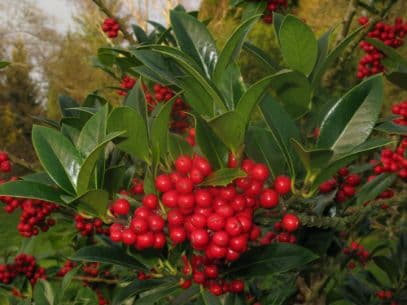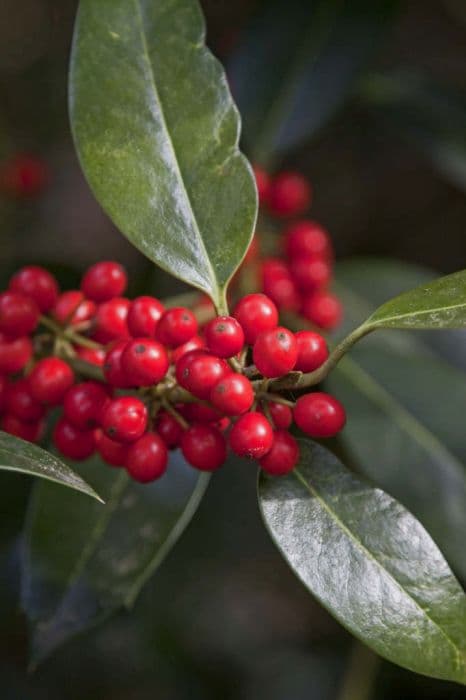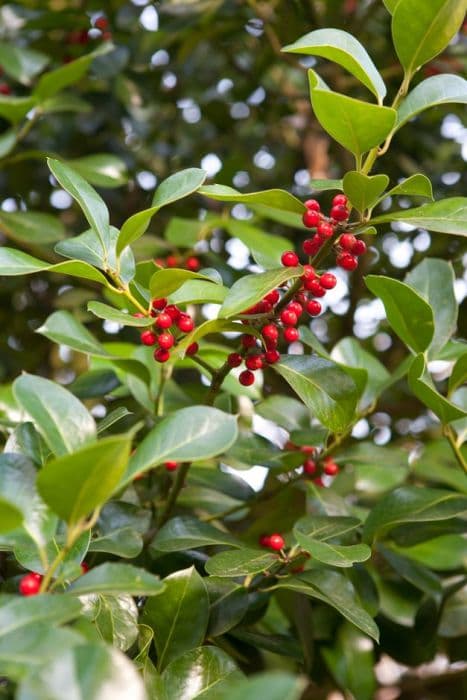Golden Variegated Holly Ilex aquifolium 'Myrtifolia Aurea Maculata' (m/v)

ABOUT
The plant commonly known as 'Golden Variegated Holly' features distinctive foliage that is both ornamental and eye-catching. Its leaves are dark green with broad, irregular golden yellow margins, providing a sharp contrast that makes the plant stand out. The foliage is glossy, adding a shimmering effect when it catches the light. The leaves have a unique shape, being somewhat oval yet with multiple spiky points along the edges, reminiscent of classic holly leaves that are associated with Christmas decorations. This spikiness gives the plant a very textural appearance. During the late fall and winter months, the plant bears red berries, which are typical of holly varieties. These berries are small and round, adding a burst of color against the foliage, and are popular with birds. Overall, the Golden Variegated Holly is prized for its variegated leaves that provide year-round interest and its seasonal red berries that contribute to its decorative appeal. It is a sturdy and resilient plant that maintains its color and vibrancy across seasons.
About this plant
 Names
NamesFamily
Aquifoliaceae
Synonyms
Golden Variegated Holly, Myrtle-Leaved Holly, Gold-Spotted Holly
Common names
Ilex aquifolium 'Myrtifolia Aurea Maculata'
 Toxicity
ToxicityTo humans
English Holly is considered to be mildly to moderately toxic to humans if ingested. The plant contains saponins, which are compounds that can cause nausea, vomiting, diarrhea, and abdominal pain if eaten in large quantities. The berries are particularly attractive but are more likely to be ingested, especially by children, due to their bright color. Eating large quantities of the berries can lead to more severe symptoms, including drowsiness, dehydration, and a slowed heart rate. It is advised to seek medical attention if English Holly is consumed.
To pets
English Holly is also toxic to pets like dogs and cats. The plant's leaves and berries contain saponins and ilicin, which can cause gastrointestinal upset if ingested, leading to symptoms such as vomiting, diarrhea, and abdominal pain. Like in humans, ingestion of large amounts of berries can be more dangerous and result in severe symptoms such as drooling, lip smacking, head shaking, and a low heart rate. If you suspect your pet has ingested English Holly, it is important to contact your veterinarian immediately.
 Characteristics
CharacteristicsLife cycle
Perennials
Foliage type
Evergreen
Color of leaves
Variegated
Flower color
White
Height
6-10 feet [1.8-3 meters]
Spread
4-8 feet [1.2-2.4 meters]
Plant type
Shrub
Hardiness zones
5-9
Native area
Europe
Benefits
 General Benefits
General Benefits- Attractive Foliage: Ilex aquifolium 'Myrtifolia Aurea Maculata' has variegated leaves that add visual interest and year-round color to gardens.
- Wildlife Habitat: Provides shelter and berries as food for birds, especially in winter when other food sources may be scarce.
- Drought Resistance: Once established, it is relatively tolerant of drought, reducing the need for supplemental watering.
- Low Maintenance: Requires minimal pruning and care once it is established in an appropriate location.
- Long-lived: Holly plants are known for their longevity, which can add lasting structure to a landscape.
- Privacy Screen: Can be used to create dense hedges or screens, contributing to privacy and reducing noise pollution.
- Adaptability: Adapts well to various soil types, although it prefers well-drained, slightly acidic soil.
- Seasonal Interest: Produces attractive red berries in the fall and winter, providing visual interest during the duller months.
- Hardiness: Tolerates cold weather well, making it suitable for a variety of climates.
- Design Versatility: It fits well into multiple design schemes, including formal gardens, woodland settings, and as specimen plants.
 Medical Properties
Medical Properties- This plant is not used for medical purposes.
 Air-purifying Qualities
Air-purifying QualitiesThis plant is not specifically known for air purifying qualities.
 Other Uses
Other Uses- Photography: The variegated leaves of Holly 'Myrtifolia Aurea Maculata' offer a visually interesting backdrop or subject for close-up photography, particularly due to their unique coloration.
- Winter Garden Interest: Its bright yellow-spotted evergreen leaves and red berries provide color and texture to winter gardens when most other plants have shed their leaves.
- Privacy Screening: Because it can grow into a dense shrub, it's used to create privacy screens in residential and commercial landscapes.
- Craft Material: The branches and leaves can be used in wreath-making and other decorative crafts, especially around the Christmas season.
- Festive Decorations: Clippings of Holly 'Myrtifolia Aurea Maculata' are often used in Christmas floral arrangements and decorations for their festive appeal.
- Ink and Dye: Historically, the berries may have been used to make natural dyes or inks, though this is less common today due to better alternatives.
- Jewelry Making: The dried berries and variegated leaves can be incorporated into homemade jewelry such as necklaces and earrings for a natural look.
- Drawing and Painting: Artists sometimes use the plant as a model for drawing and painting exercises to capture its complex leaf patterns and bright colors.
- Culinary Garnish: While the plant is not edible, it can be used as a garnish for festive dishes, provided it does not come into contact with the food.
- Texture in Ponds and Water Features: When planted near ponds or water features, its reflection adds texture and visual depth to the water's surface.
Interesting Facts
 Feng Shui
Feng ShuiThe English Holly is not used in Feng Shui practice.
 Zodiac Sign Compitability
Zodiac Sign CompitabilityThe English Holly is not used in astrology practice.
 Plant Symbolism
Plant Symbolism- Protection: Ilex aquifolium, commonly known as Holly, is often believed to ward off evil spirits and negative energies, hence it symbolizes protection.
- Good Fortune: Holly is associated with bringing good luck and is often used in decorations to attract positive outcomes, especially during Christmas.
- Fertility: With its robust growth and evergreen nature, Holly can represent fertility and life's continuation.
- Hope: The evergreen leaves of Holly signify hope and the ability to endure hardships, as it stays green even in the harshest winters.
- New Beginnings: Because Holly is evergreen, it's often associated with renewal and the fresh starts that come with the new year.
 Water
WaterGolden Variegated Holly should be watered thoroughly once the top inch of soil feels dry to the touch. During the growing season, this typically means weekly watering, but always check the soil moisture before watering. Be cautious not to overwater, as this plant does not like to sit in waterlogged soil. Use a watering can or hose to gently water at the base of the plant, avoiding wetting the foliage to prevent leaf burn or disease spread. Each watering should be deep enough to soak the root zone, which might mean around 1-2 gallons for a medium-sized plant, depending on soil type and weather conditions.
 Light
LightGolden Variegated Holly thrives in partial to full sunlight, so choose a location where the plant will receive at least four to six hours of direct sunlight daily. An east-facing or south-facing aspect is ideal, ensuring the plant gets bright light to retain its vibrant variegated leaf pattern while avoiding the intense late afternoon sun that could scorch the leaves.
 Temperature
TemperatureGolden Variegated Holly prefers temperate climates and can usually withstand temperatures ranging from around 20°F to 80°F. However, it grows best when the temperature is maintained between 50°F and 70°F. Protect the plant from extreme cold and frost, which can damage leaves and stems, by providing shelter or mulch around the root zone in colder regions.
 Pruning
PruningPrune Golden Variegated Holly to maintain shape, encourage bushy growth, or remove any dead or diseased branches. The best time for pruning is in late winter or early spring before new growth begins. Pruning can be done as needed throughout the year to correct any irregularities, but avoid heavy pruning late in the season as this can harm the plant.
 Cleaning
CleaningAs needed
 Soil
SoilThe best soil mix for English Holly 'Myrtifolia Aurea Maculata' should be well-draining and fertile with a mix of loam, peat, and sand or perlite; aiming for a pH level of about 5.5 to 6.5 works well for this cultivar.
 Repotting
RepottingEnglish Holly 'Myrtifolia Aurea Maculata' typically needs repotting every 2 to 3 years or if you notice the roots have filled the pot and it becomes root-bound.
 Humidity & Misting
Humidity & MistingEnglish Holly 'Myrtifolia Aurea Maculata' thrives in average to high humidity levels but it is quite adaptable and can also tolerate low humidity conditions typically found in most home environments.
 Suitable locations
Suitable locationsIndoor
Provide indirect light and avoid extreme temperatures for indoor English Holly.
Outdoor
Plant in partial shade, sheltered from wind for outdoor English Holly.
Hardiness zone
6-9 USDA
 Life cycle
Life cycleHolley 'Myrtifolia Aurea Maculata' starts its life as a seed, which upon germination develops into a seedling with its first true leaves. As a juvenile, it grows steadily, forming a small shrub with distinctive spiny, variegated foliage that is golden-yellow with dark green centers. The plant reaches maturity in several years, at which point it can produce small white flowers, typically in late spring. Once pollinated, these flowers give way to red berries (drupes) that mature in the fall and can persist into winter, providing food for birds. The mature holly can live for many years, growing into a densely branched evergreen shrub or small tree. Over time, it may become leggy or bare at the base, necessitating pruning to rejuvenate its growth and maintain its ornamental appearance.
 Propogation
PropogationPropogation time
Spring to early summer
Propogation: Ilex aquifolium 'Myrtifolia Aurea Maculata', commonly known as the variegated myrtle-leaved holly, is typically propagated through semi-hardwood cuttings. This method is often carried out during late summer to early autumn when the plant's growth has begun to mature yet is not completely hard. Cuttings are taken from the current year's growth, with each cutting measuring about 4 to 6 inches (approximately 10 to 15 centimeters) long, ensuring that a few leaves remain at the top. The lower leaves are removed, and the cut end may be dipped in rooting hormone to encourage root development. The prepared cuttings are then inserted into a pot filled with a mix of half perlite and half peat to provide good drainage and moisture retention. The pot is placed in a warm area with indirect light and maintained with consistent moisture until the cuttings root, which can take several weeks to a few months. Covering the pot with a plastic bag can help maintain humidity levels conducive to rooting.









